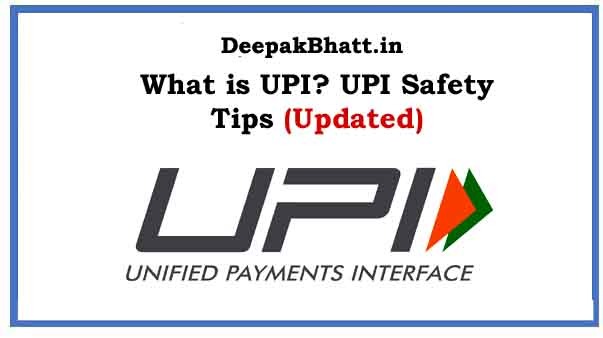What is UPI UPI stands for Unified Payments Interface, which is a real-time payment system developed
by the National Payments Corporation of India (NPCI).
It allows users to transfer funds from one bank account to another bank account instantly and securely using a mobile device.
UPI enables users to link multiple bank accounts to a single mobile application, providing a seamless payment experience.
Complete JavaScript Freemium Course
Learn Ethical Hacking From Scratch
- 1 What is UPI
- 1.1 Features of UPI
- 1.2 How to works UPI
- 1.3 UPI Safety Tips
- 1.4 Why Should You Use UPI?
- 1.5 Registration Process in UPI enabled application
- 1.6 Generating UPI PIN
- 1.7 What is Unified Payments Interface (UPI) Transaction?
- 1.8 Ways to Transfer Money Through UPI
- 1.9 How to Make a UPI Transaction?
- 1.10 Is KYC Required For UPI Money Transfer?
- 1.11 UPI Transaction Limit
- 1.12 UPI Transactions Fees and Charges
- 2 UPI History
What is UPI
UPI has become increasingly popular in India, with more and more people using it for various transactions, including paying bills, making purchases, transferring money to friends and family, and more.
The system is available 24×7, and transactions can be initiated and completed within seconds. Additionally, UPI is a cost-effective payment option, as it does not charge any transaction fees for most transactions.
Top 5 Payment Gateway Apps in India
Features of UPI
Here are some of the key features of UPI:
Instant Fund Transfer:
UPI allows instant money transfers from one bank account to another. The money transfer happens in real-time, making it one of the quickest ways to send and receive money.
24/7 Availability:
UPI is available 24/7, which means you can transfer money anytime and anywhere.
Multiple Bank Accounts:
UPI enables users to link multiple bank accounts to a single mobile application. This feature eliminates the need to remember multiple passwords and login credentials.
QR Code Payments:
UPI supports payments through QR codes, making it easier for merchants to receive payments.
Bill Payments:
UPI allows users to pay bills, including electricity, water, gas, and more, through the mobile application.
Security:
UPI transactions are secured with a two-factor authentication process, ensuring the safety of your transactions.
Low Transaction Cost:
UPI does not charge any transaction fees for most transactions, making it a cost-effective payment option. However, some banks may charge a nominal fee for certain transactions.
Overall, UPI provides a convenient and seamless way to send and receive money, making it a popular payment option in India.
How to works UPI
Here’s how UPI works:
User Registration: To use UPI, a user needs to download the UPI-enabled mobile application from their bank or any other UPI-enabled app. Once the app is downloaded, the user needs to register by providing their mobile number and linking their bank account to the UPI application.
Create UPI ID: After registration, the user creates a unique Virtual Payment Address (VPA), also known as a UPI ID. This ID acts as an alias for the user’s bank account number and eliminates the need to share the actual bank account number.
Transaction Initiation: To initiate a transaction, the user needs to open the UPI-enabled app and select the ‘Send Money’ option. They then need to enter the recipient’s VPA or mobile number, the transaction amount, and an optional description.
Transaction Authorization: The UPI app sends a payment request to the user’s linked bank account. The user then needs to authorize the transaction by entering their UPI PIN, which is a 4 or 6 digit number set during the registration process.
Transaction Settlement: After the user authorizes the transaction, the amount is instantly debited from their bank account and transferred to the recipient’s bank account.
Confirmation: Once the transaction is complete, both the sender and the recipient receive a confirmation message on their respective UPI-enabled mobile applications.
UPI Safety Tips
Here are some safety tips to keep in mind while using UPI:
Keep UPI PIN confidential: Never share your UPI PIN with anyone, and avoid writing it down anywhere. Also, avoid using common numbers like your date of birth, phone number, or any other easily guessable number as your UPI PIN.
Use a secure device: Always use a secure and updated device to access your UPI-enabled mobile application. Avoid using public Wi-Fi networks or unsecured networks to make transactions.
Verify recipient details: Always double-check the recipient’s VPA or bank account number before initiating a transaction. A small mistake in the details can lead to transferring the money to the wrong person.
Enable two-factor authentication: Enable two-factor authentication for your UPI transactions to add an extra layer of security. It can include fingerprint or face recognition, pattern lock, or a passcode.
Check transaction history: Regularly check your UPI transaction history to ensure that all transactions are authorized by you. If you find any unauthorized transactions, report them to your bank immediately.
Avoid responding to unsolicited calls/messages: Avoid responding to unsolicited calls or messages claiming to be from your bank or UPI. Do not share any sensitive information like UPI PIN, OTP or account details over phone calls or messages.
By following these safety tips, you can ensure that your UPI transactions are safe and secure. If you ever face any issues or have any concerns, contact your bank immediately.
Why Should You Use UPI?
Here are some safety tips to keep in mind while using UPI:
Keep UPI PIN confidential:
Never share your UPI PIN with anyone, and avoid writing it down anywhere. Also, avoid using common numbers like your date of birth, phone number, or any other easily guessable number as your UPI PIN.
Use a secure device:
Always use a secure and updated device to access your UPI-enabled mobile application. Avoid using public Wi-Fi networks or unsecured networks to make transactions.
Verify recipient details:
Always double-check the recipient’s VPA or bank account number before initiating a transaction. A small mistake in the details can lead to transferring the money to the wrong person.
Enable two-factor authentication:
Enable two-factor authentication for your UPI transactions to add an extra layer of security. It can include fingerprint or face recognition, pattern lock, or a passcode.
Check transaction history:
Regularly check your UPI transaction history to ensure that all transactions are authorized by you. If you find any unauthorized transactions, report them to your bank immediately.
Avoid responding to unsolicited calls/messages:
Avoid responding to unsolicited calls or messages claiming to be from your bank or UPI. Do not share any sensitive information like UPI PIN, OTP or account details over phone calls or messages.
Registration Process in UPI enabled application
Here is a general registration process to use UPI-enabled applications:
Download UPI-Enabled Application:
Download any UPI-enabled mobile application from the Google Play Store or the App Store, such as Google Pay, PhonePe, BHIM, etc.
Choose Language:
Select your preferred language and click on ‘Next.’
Verify Mobile Number:
Enter your mobile number registered with your bank and click on ‘Next.’ The UPI-enabled application will automatically verify your mobile number by sending an SMS.
Select Bank:
Choose your bank from the list of UPI-enabled banks displayed on the screen.
Enter Bank Details:
Enter your bank account details, such as account number and IFSC code, to link your bank account to the UPI-enabled application.
Create UPI ID:
Create a Virtual Payment Address (VPA) or UPI ID. This ID acts as an alias for your bank account number and eliminates the need to share the actual bank account number.
Set UPI PIN:
Set your UPI PIN, which is a 4 or 6 digit number that you will use to authenticate your transactions.
Verify Bank Account:
Verify your bank account by entering the last six digits of your debit card number and its expiry date.
Enable Two-Factor Authentication:
Enable two-factor authentication for added security. This can include fingerprint or face recognition, pattern lock, or a passcode.
Once you complete these steps, you can start using the UPI-enabled application to send and receive money, pay bills, and perform other transactions. The registration process may vary slightly based on the UPI-enabled application you use.
Generating UPI PIN
You can generate your UPI PIN in the following ways:
Using Debit Card Details:
Most UPI-enabled applications allow you to generate your UPI PIN using your debit card details. To do this, select the ‘Create UPI PIN’ option and enter the last six digits of your debit card number and its expiry date. You will receive an OTP on your registered mobile number. Enter the OTP and set your desired UPI PIN.
Using Net Banking:
Some banks also offer the option to generate your UPI PIN using their net banking portal. To do this, log in to your net banking account, select the UPI option, and choose the ‘Generate UPI PIN’ option. Follow the on-screen instructions to set your UPI PIN.
Using ATM:
If you do not have access to net banking or a UPI-enabled application, you can also generate your UPI PIN at an ATM. Insert your debit card, select the ‘Generate UPI PIN’ option, and follow the instructions displayed on the screen.
Note: The process to generate UPI PIN may vary slightly based on the UPI-enabled application or the bank you are using.
What is Unified Payments Interface (UPI) Transaction?
Unified Payments Interface (UPI) is a real-time payment system that enables instant fund transfer between bank accounts in India.
UPI transactions can be made through a mobile phone or a UPI-enabled application, without the need for bank account details of the recipient.
UPI is an initiative of the National Payments Corporation of India (NPCI) and is regulated by the Reserve Bank of India (RBI).
UPI transactions can be initiated by providing a Virtual Payment Address (VPA), which is a unique identifier for a bank account that is linked to a mobile number.
UPI also allows users to link multiple bank accounts to a single mobile application. The maximum transaction limit for UPI is currently set at Rs. 1 lakh per transaction.
UPI supports various types of transactions, including person-to-person (P2P) transfers, merchant payments, and bill payments.
Users can make UPI transactions by selecting the recipient’s VPA or scanning a QR code.
UPI also provides additional security features such as two-factor authentication, which includes biometric authentication or an MPIN.
Overall, UPI has made digital payments faster, safer, and more convenient.
It has become one of the most popular modes of digital transactions in India, with over 2.3 billion transactions in January 2022.
Ways to Transfer Money Through UPI
There are various ways to transfer money through UPI. Here are some of the common methods:
Using Virtual Payment Address (VPA):
To transfer money through UPI using VPA, the sender needs to enter the recipient’s unique VPA in the UPI-enabled application.
Once the VPA is verified, the sender can enter the amount to be transferred and complete the transaction by entering the UPI PIN.
Using Mobile Number and IFSC:
If the recipient does not have a VPA, the sender can still transfer money by entering the recipient’s mobile number and the bank’s IFSC code.
The UPI-enabled application will fetch the recipient’s bank details based on the mobile number and IFSC code entered by the sender.
Using QR Code:
Another way to transfer money through UPI is by scanning the recipient’s QR code.
The UPI-enabled application will fetch the recipient’s VPA and bank details from the QR code, and the sender can complete the transaction by entering the UPI PIN.
Using Aadhaar Number:
UPI also allows money transfer using Aadhaar number. The sender needs to enter the recipient’s Aadhaar number and bank details in the UPI-enabled application to transfer the money.
AutoPay:
UPI-enabled applications also provide the AutoPay feature, which allows users to set up automatic payments for recurring bills, such as mobile bills, electricity bills, etc.
These are some of the common methods to transfer money through UPI. The actual process may vary slightly depending on the UPI-enabled application used.
How to Make a UPI Transaction?
Here’s how to make a UPI transaction:
Open the UPI-Enabled Application:
Open any UPI-enabled mobile application such as Google Pay, PhonePe, BHIM, etc., on your mobile phone.
Select the Payment Option:
Select the ‘Send Money’ or ‘UPI Payment’ option from the home screen.
Enter Recipient Details:
Enter the recipient’s Virtual Payment Address (VPA), mobile number, or bank account details, depending on the payment option you choose.
You can also select the recipient from your contact list, if the contact is also registered on UPI.
Enter Amount:
Enter the amount to be transferred.
Add Remarks:
You can also add a remark or a message for the recipient.
Verify Payment Details:
Verify the payment details, such as the recipient’s name, account details, and amount to be transferred.
Enter UPI PIN:
Enter your UPI PIN to authenticate the transaction.
Transaction Confirmation:
Once the transaction is successful, you will receive a confirmation message on the application.
Note: The exact process may vary slightly depending on the UPI-enabled application used.
Additionally, some UPI-enabled applications may offer additional features such as QR code payments or voice-based transactions.
Overall, UPI transactions are simple, fast, and secure, making it a popular mode of digital payments in India.
Is KYC Required For UPI Money Transfer?
Yes, KYC (Know Your Customer) is required for UPI money transfer. As per the Reserve Bank of India (RBI) guidelines, all UPI transactions require KYC of the user.
The KYC process involves verifying the user’s identity and address proof. KYC is mandatory for all UPI-enabled applications and is a one-time process.
The KYC process can be completed online or offline. The online KYC process requires the user to enter their Aadhaar number, PAN card details, or other identity documents.
The offline KYC process involves submitting physical documents such as passport, driving license, or voter ID card to the bank or the UPI-enabled application provider.
Once the KYC process is completed, the user can make UPI transactions without any restrictions. KYC helps in preventing fraud and ensures the security of digital transactions. Therefore, it is important to complete the KYC process before making UPI transactions.
UPI Transaction Limit
The National Payments Corporation of India (NPCI) has set different transaction limits for UPI transactions based on the type of transaction and the UPI-enabled application used. Here are the UPI transaction limits:
Per Transaction Limit: The per transaction limit for UPI transactions is Rs. 1 lakh.
Daily Transaction Limit: The daily transaction limit for UPI transactions varies depending on the UPI-enabled application. For most applications, the daily limit is Rs. 1 lakh to Rs. 2 lakh. Some applications allow users to increase the daily limit by completing additional KYC.
Number of Transactions: There is no limit on the number of transactions that can be made in a day through UPI.
It is important to note that some banks or UPI-enabled applications may set lower transaction limits for security purposes.
The actual transaction limits may vary depending on the bank or the UPI-enabled application used.
Additionally, the NPCI periodically revises the transaction limits based on market conditions and the evolving security landscape.
Overall, UPI transactions offer a convenient, fast, and secure way of making digital payments in India.
UPI Transactions Fees and Charges
Most UPI-enabled applications and banks do not charge any transaction fees for UPI transactions.
UPI transactions are free for customers as the cost of the transaction is borne by the bank or the payment service provider.
However, there may be some charges associated with UPI transactions in certain cases, such as:
Merchant Transactions: Merchants may have to pay a nominal fee to accept UPI payments. This fee is typically charged as a percentage of the transaction value.
Cash Withdrawals: Some UPI-enabled applications allow users to withdraw cash from ATMs using UPI. In such cases, the ATM may charge a nominal fee for the cash withdrawal.
Reversals: If a UPI transaction fails or is canceled, some banks may charge a nominal fee for processing the reversal.
It is important to check with your bank or UPI-enabled application for any charges associated with UPI transactions.
Additionally, some banks may offer additional services such as premium UPI services or priority transaction processing for a fee.
In such cases, the bank or UPI-enabled application may charge a fee for the premium service. Overall, UPI transactions remain a cost-effective mode of digital payments in India.
UPI History
The Unified Payments Interface (UPI) was launched in India on April 11, 2016, by the National Payments Corporation of India (NPCI), the umbrella organization that operates retail payment and settlement systems in India.
The UPI was developed with the aim of enabling fast, secure, and convenient payments and fund transfers through mobile devices.
The UPI platform was developed with the help of a consortium of banks and other financial institutions and was launched under the Digital India initiative of the Government of India.
The UPI was launched with 21 banks, and since then, the platform has grown rapidly.
Today, more than 200 banks and payment service providers offer UPI services, and the UPI platform has emerged as one of the most popular payment systems in India.
According to the NPCI, the UPI recorded 2.73 billion transactions worth Rs. 5.47 lakh crore in January 2021, which is a testament to the popularity and the success of the UPI platform.
The UPI platform has undergone several improvements and updates since its launch. The NPCI has introduced new features such as UPI 2.0, which allows customers to link their overdraft accounts, schedule transactions, and make payments through QR codes.
The NPCI has also introduced new security features such as two-factor authentication and limits on transaction amounts to ensure the safety and security of UPI transactions.
Overall, the UPI platform has transformed the way digital payments are made in India and has played a significant role in promoting a cashless economy.
The success of UPI has also inspired other countries to develop their own payment systems, and several countries are now looking to emulate the Indian model to promote digital payments.

















